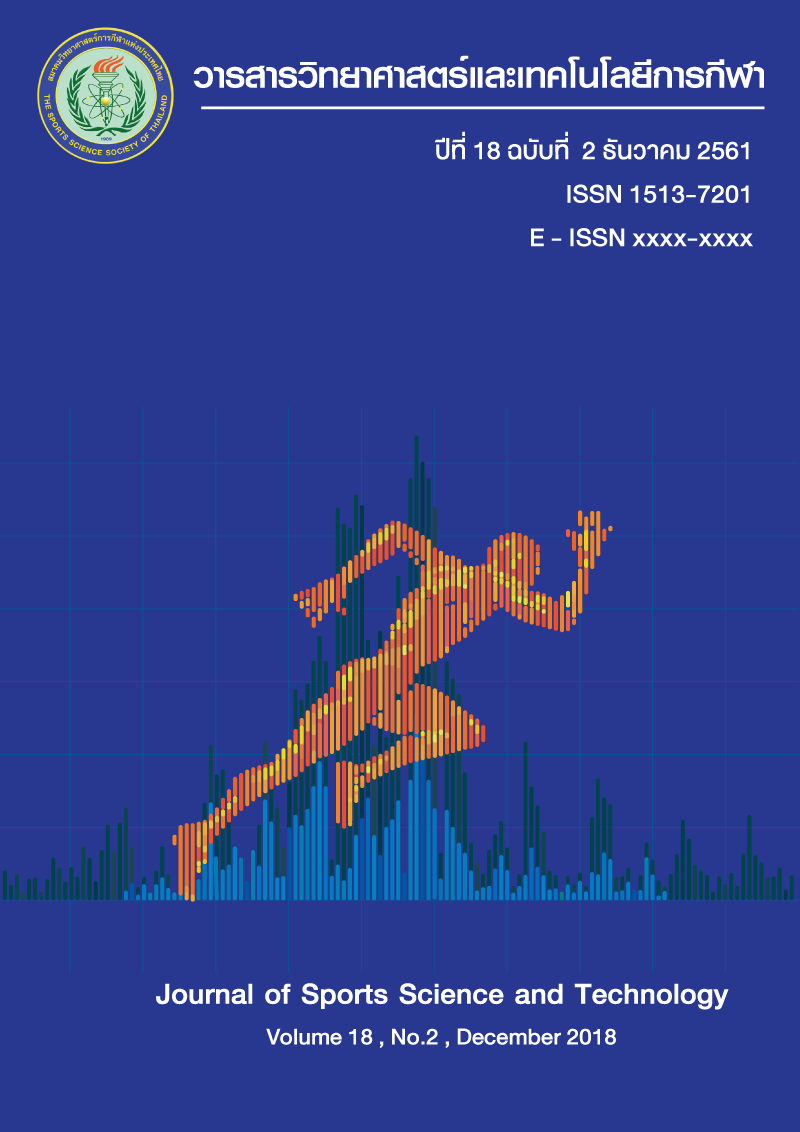The EFFECT OF INCREASING NUMBER OF BALL ON PHYSIOLOGICAL RESPONSE, MOVEMENT DEMAND AND TECHNICAL SKILL DURING SMALL SIDE SOCCER GAME TRAINING
Keywords:
N/A, เกมสนามเล็ก / การตอบสนองทางสรีรวิทยา / ปริมาณการเคลื่อนที่ / ทักษะที่ใช้Abstract
The purposes of this research were to study of effect on physiological response, movement demand and technical skill (passing receiving dribbing heading andshooting) during small side soccer game training by using one ball and two ball. Sixteen male, aged 18-22 years old who were soccer players form Kasetsart University Kamphaengsean Campus team participated in this study. All subjects were performed 8-a side small-sided games (SSG), each side have a goalkeeper and field sizes were 45 x 60 m. SSG included using one ball and two ball games consisting of 2 bouts of 10 min duration with 5 min recovery between bouts. The physiological response, movement demand and technical skill were measured during SSG training. Data were analyzed using mean, standard deviation, Paired t-test and Chi square. All tests used the 0.05 level of significance. The result showed that percent of maximum heart rate during SSG training with using two ball were significantly higher (P<0.05) than using one ball (77.80±7.96% and 75.31±7.91% respectively). While the total distance cover of SSG training with using two ball was significantly lower (p<0.05) than using one ball training (786.43±120.70 meter and 843.65±98.02 meter respectively). There were no significant difference (p<0.05) between technical skill of two SSG training program, but the number of technical skill with using two ball were seem higher than using one ball training. Therefore, the benefit of this study will be using small side game with two ball applied to developed physical fitness and technical skills in soccer.
(Journal of Sports Science and Technology 2018; 18(2): 35 - 47)
Keywords: Small Side Game / Physiological Response / Movement Demand / Technical Skill
* Corresponding author: Niromlee MAKAJE Department of Sports Science and Health, Faculty of Sports Science Kasetsart University, Kampheangsean Campus Nakhon Pathom, THIALAND. 73140 Email: [email protected]
References
2. Reilly T. Motion analysis and physiological demands. Science and soccer: Routledge; 2003:67-80.
3. Dellal A, Chamari K, Pintus A, Girard O, Cotte T, Keller D. Heart rate responses during small-sided games and short intermittent running training in elite soccer players: a comparative study. J Strength Cond Res. 2008;22(5):1449-57.
4. Williams K, Owen A. The impact of player numbers on the physiological responses to small sided games. J Sports Sci Med. 2007;6(Suppl 10):100.
5. Owen A, Twist C, Ford P. Small-sided games: the physiological and technical effect of altering pitch size and player numbers. Insight. 2004;7(2):50-3.
6. Hill-Haas SV, Dawson B, Impellizzeri FM, Coutts AJ. Physiology of small-sided games training in football. Sports Med. 2011;41(3):199-220.
7. Sassi R, Reilly T, Impellizzeri F. A comparison of small-side games and interval training in elite professional soccer players. Science and football V Oxon: Routledge. 2005:352-4.
8. Mallo J, Navarro E. Physical load imposed on soccer players during small-sided training games. J Sports Med Phys Fitness. 2008;48(2):166.
9. Rampinini E, Impellizzeri FM, Castagna C, Abt G, Chamari K, Sassi A, et al. Factors influencing physiological responses to small-sided soccer games. J Sports Sci. 2007;25(6):659-66.
10. Phetcharat S, Makajae N, Pimpaporn P. The physiological responses technical skill and acute effect of warm up with small side game on speed and agility in young soccer players. J Sports Sci Tech. 2014;14(1):26-39.
11. Hoff J, Wisløff U, Engen LC, Kemi OJ, Helgerud J. Soccer specific aerobic endurance training. Br J Sports Med. 2002;36(3):218-21. 12. Reuter B, Hagerman P. Essentials of strength training and conditioning. Champaign, IL: Human Kinetics; 2008.
13. Guyenet PG. The sympathetic control of blood pressure. Nature Rev Neurosci. 2006;7(5):335.
14. Di Salvo V, Baron R, González-Haro C, Gormasz C, Pigozzi F, Bachl N. Sprinting analysis of elite soccer players during European Champions League and UEFA Cup matches. J Sports Sci. 2010;28(14):1489-94.






